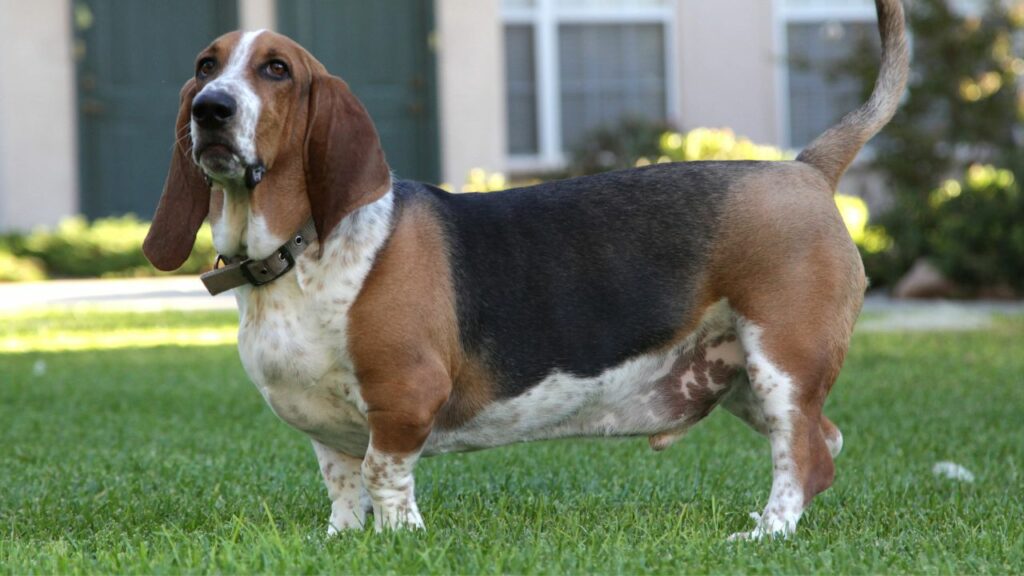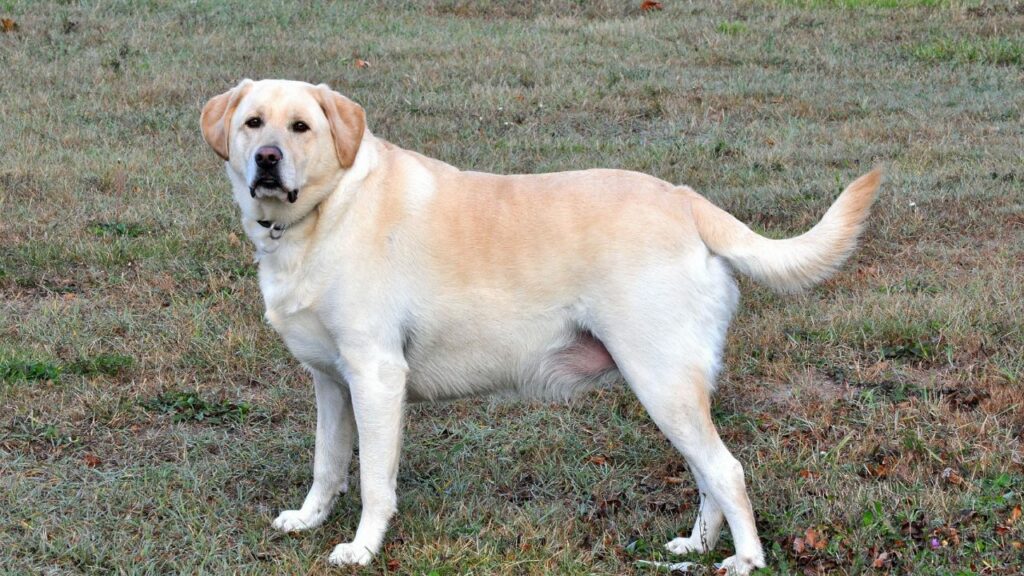WorldAnimalFoundation.org is reader-supported. When you buy through links on our site, we may earn an affiliate commission. Learn More
Dogs truly hold a special place in our hearts, so much so that we often can’t help but spoil them throughout the day. Whether it’s an extra treat “just because” or a sneak of dinner scraps under the table, our love for our furry friends knows no bounds. In fact, a recent survey revealed that 9.3 percent of dog owners in the U.S., Canada, and Europe give their dogs table scraps daily, while 38.1 percent do so occasionally.
However, these well-intentioned snacks can accumulate, leading to overfeeding. This trend has contributed significantly to pet obesity, which is on the rise. According to the 2022 State of Pet Obesity Report, 59% of dogs in the United States are now classified as overweight or obese.
Obesity not only shortens a dog’s life—often by 6 to 12 months—but also increases their risk of developing multiple diseases, as noted by VCA Animal Hospitals. Managing weight can be particularly challenging for certain breeds that are more prone to obesity.
To help dog owners understand and manage this condition, we’ve identified and will explore seven dog breeds that are most susceptible to obesity. We will shed light on how to keep our cherished pets healthy and happy.
Fattest Dog Breeds
1. Bulldogs

| Personality | Friendly, courageous, calm |
| Energy Level | Regular Exercise |
| Height | 14-15 inches |
| Weight | 50 pounds (male), 40 pounds (female) |
| Life Expectancy | 8-10 years |
Bulldogs are the most likely dog breed to become overweight, often because they naturally have a stockier build. Known for their gentle nature, love for children, and playful behavior, bulldogs make intelligent and loyal family pets. They form strong bonds with people, especially when they are well-socialized and guided by consistent leadership.
However, bulldogs are not very active. They have low energy levels, which makes it harder for them to keep a healthy weight. They don’t need much exercise, but what they do need is crucial for their health. Bulldogs do best in mild climates since they can overheat easily and also struggle in cold temperatures.
According to Point Vicente Vet, obesity is a major health issue for bulldogs, leading to or aggravating joint problems, metabolic and digestive disorders, back pain, and heart disease. While it’s hard to resist those pleading eyes, feeding your bulldog table scraps or too many treats can be harmful.
Instead, show your love with a hug, by brushing her fur or teeth, playing a game, or taking her for a walk. Regular care, a proper diet, and exercise are essential to keep your bulldog healthy, happy, and fit throughout her life.
2. Golden Retrievers

| Personality | Friendly, intelligent, devoted |
| Energy Level | Needs Lots of Activity |
| Height | 23-24 inches (male), 21.5-22.5 inches (female) |
| Weight | 65-75 pounds (male), 55-65 pounds (female) |
| Life Expectancy | 10-12 years |
America’s beloved Golden Retriever is, unfortunately, also one of the breeds most affected by obesity. Shockingly, about 63% of Golden Retrievers are overweight, a statistic highlighted by the Association for Pet Obesity Prevention.
Known for their even temperament, intelligence, and affection, Golden Retrievers are friendly and gentle with both children and other animals. However, their love for food and their owners’ tendency to indulge them can lead to weight problems. They are enthusiastic eaters with a big appetite for just about anything.
HICC Pet notes that obesity in Golden Retrievers can lead to joint issues, heart disease, diabetes, and a reduced lifespan. Overfeeding, excessive pampering, and insufficient exercise are common factors contributing to this condition. Signs of obesity include rib pain, a lack of a visible waistline, lethargy, and difficulty with physical activities.
Preventing obesity in Golden Retrievers involves managing their calorie intake and ensuring they get regular exercise. Consulting with a veterinarian to choose the right high-quality, nutrient-rich dog food and appropriate portion sizes is essential. Avoiding snacks and table scraps is crucial, as they can significantly contribute to weight gain. Regular walks, active play, and mental stimulation are also necessary to maintain a healthy weight and overall good health.
3. Dachshunds

| Personality | Friendly, curious, spunky |
| Energy Level | Regular Exercise |
| Height | 8-9 inches (standard), 5-6 inches (miniature) |
| Weight | 16-32 pounds (standard), 11 pounds & under (miniature) |
| Life Expectancy | 12-16 years |
Dachshunds, with their distinctively low stature, are charming but often struggle with weight issues. Their unique body shape, characterized by a long back and short legs, makes them especially prone to becoming overweight. This can lead to severe health problems, including strain on their hips and spine, potentially shortening their lifespan.
These energetic and fun-loving dogs also have an independent and sometimes stubborn nature. They are known for being expert beggars and are frequently carried due to their small size, both of which can contribute to weight gain. It’s crucial to recognize the signs of extra weight since obesity can cause significant health issues for Dachshunds.
Exercise can be challenging for Dachshunds due to common back problems, making it painful for them to stay active. A balanced diet rich in whole foods, coupled with regular, suitable exercise, is essential to prevent your Dachshund from gaining excess weight.
Keeping your dog fit protects its spine and overall well-being. Be vigilant about any sudden weight changes, as these could indicate more serious health issues, such as hypothyroidism. If you notice any unexpected weight gain or if your dog seems unusually tired, consult your veterinarian promptly to address these concerns.
4. Beagles

| Personality | Friendly, curious, merry |
| Energy Level | Energetic |
| Height | 13 inches & under, 13-15 inches |
| Weight | under 20 pounds (13 inches & under), 20-30 pounds (13-15 inches) |
| Life Expectancy | 10-15 years |
The Beagle is a popular dog breed among American dog owners, cherished for its happy-go-lucky and affectionate demeanor. However, these curious and intelligent dogs can easily find themselves in trouble without enough playtime and mental stimulation.
Despite their energetic and active nature, Beagles are surprisingly prone to obesity. Originally bred for tracking, hunting, and working, Beagles can gain weight quickly if their lifestyle doesn’t align with their intended purpose. They have an immense appetite and are known for eating rapidly, often without savoring their food. These dogs will consume anything in sight and might even snatch food off your plate if given a chance.
Therefore, it’s crucial to portion out their meals carefully. They’ll continue eating long after they’re full if allowed, making it essential for owners to monitor their weight and diet closely.
Being overweight puts a Beagle at risk for several serious health issues, including arthritis, diabetes, damage to ligaments and tendons, breathing difficulties, snoring, heart disease, and conditions like Cushing’s and Addison’s disease, ultimately reducing their life expectancy.
To help manage their weight and fulfill their needs, it’s vital to keep your Beagle active daily. Long walks are beneficial, and you can even engage their natural tracking instincts by hiding treats for them to find, providing both physical exercise and mental stimulation.
5. Basset Hounds

| Personality | Charming, patient, low-key |
| Energy Level | Calm |
| Height | up to 15 inches |
| Weight | 40-65 pounds |
| Life Expectancy | 12-13 years |
Basset Hounds are known for their good-natured and friendly disposition, yet they also display an independent and stubborn streak. They are quite vocal, often expressing their excitement or frustration through loud barking. Despite their low energy levels and somewhat clumsy gait due to their short legs, Basset Hounds do enjoy playful activities. However, their distinctive short legs can be susceptible to arthritis.
These dogs possess a remarkable sense of smell, which can lead them to track food, people, and objects with an instinctive prowess. This strong tracking ability can sometimes cause them to wander if they pick up a scent. Given their love for food, Bassets are particularly vulnerable to obesity. It’s crucial to monitor their eating habits closely and manage their diet diligently to prevent weight gain. They are experts at using their pleading eyes to coax extra treats from their owners, but succumbing to these requests can lead to less activity and more health issues.
According to PetMD, Basset Hounds’ tendency towards obesity is aggravated by their naturally low energy levels. It’s important to adhere strictly to the recommended feeding amounts on the dog food package or those provided by your veterinarian. Always measure their food portions precisely.
Basset Hounds’ keen sense of smell can detect food that other dogs might miss, leading them to beg or even steal food. To avoid encouraging this behavior, it’s best to refrain from feeding them human food, which can be high in unnecessary calories and may increase their desire for it.
6. Pugs

| Personality | Charming, loving, mischievous |
| Energy Level | Regular Exercise |
| Height | 10-13 inches |
| Weight | 14-18 pounds |
| Life Expectancy | 13-15 years |
The Pug is a delightful companion dog known for being extremely playful and affectionate. This breed balances confidence without recklessness and affection without dependency, often displaying a cheerful and sometimes comedic demeanor. However, Pugs are notably prone to obesity, with research indicating that nearly 17% of the breed is diagnosed with obesity annually. This is more than three times the likelihood compared to other dogs.
Several factors contribute to this tendency. Pugs have a robust appetite and are generally not fussy about their food, often eating anything they are offered quickly. As a brachycephalic breed with short legs, Pugs struggle with exercise compared to breeds with longer legs and snouts, which can lead to less activity and more weight gain.
Pugs naturally have low energy and may seem content lounging around the house. This sedentary preference makes it easy for them to gain weight unnoticed until it becomes a significant issue.
Given these challenges, it’s crucial to manage a Pug’s weight proactively. They often find it difficult to cope with reduced food quantities, so the most effective approach to help a Pug lose weight isn’t necessarily to feed them less but to opt for food that is lower in calories. Regular, gentle exercise tailored to their capabilities is also important to keep them active and healthy.
7. Labrador Retrievers

| Personality | Friendly, active, outgoing |
| Energy Level | Needs Lots of Activity |
| Height | 22.5-24.5 inches (male), 21.5-23.5 inches (female) |
| Weight | 65-80 pounds (male), 55-70 pounds (female) |
| Life Expectancy | 11-13 years |
Labrador Retrievers are often thought of as insatiable when it comes to food, seemingly possessing a bottomless pit for a stomach. Recent research has shed light on why this might be the case, revealing that nearly a quarter of Labradors carry a gene mutation that significantly impacts their weight.
This genetic “double-whammy” not only makes Labradors feel constantly hungry, particularly between meals but also reduces their ability to burn calories efficiently. As a result, most of the calories they consume that are not immediately used for energy are stored as fat, making them prone to rapid weight gain compared to other breeds.
This genetic predisposition has led to Labradors having the highest obesity rate among all dog breeds, a situation that is increasingly common and concerning. For owners of Labradors, managing their pet’s diet is crucial. It is important to be disciplined about feeding routines and to avoid succumbing to those pleading eyes asking for more food.
In addition to strict diet management, regular and consistent exercise is essential. Engaging Labradors in regular physical activities not only helps burn off excess calories but also keeps them healthy and happy.
Remembering the World’s Heaviest Dog

Zorba, a colossal dog known for being the heaviest ever, tipped the scales at an astounding 343 pounds. Owned by Chris Eraclides, Zorba lived in London, England, and left an unforgettable mark in canine history. Sadly, Zorba passed away in 1992, leaving behind a legacy as one of the most massive dogs ever recorded.
Top Methods for Helping Dogs Lose Weight

Explore the most popular strategies pet owners use to manage their dogs’ weight. From adjusting meal sizes to increasing exercise, this chart reveals the common approaches to ensuring a healthier lifestyle for our furry friends.
Final Thought
Missy Simpson, an epidemiologist with the Morris Animal Foundation’s Canine Lifetime Health Project, advises that controlling a dog’s diet by avoiding high-calorie and high-fat foods, coupled with plenty of exercise, can manage their weight effectively. The foundation also notes that similar to humans, dogs might eat to relieve stress, and offering new types of food frequently might increase their risk of overeating.
Certain dog breeds, like the Basset Hound and many more, are more susceptible to weight gain due to their physical and genetic makeup. Originally bred for specific tasks, these breeds often require a tailored approach to maintain their ideal weight.
A high-quality diet and consistent daily exercise are crucial for keeping these dogs healthy. By understanding the needs of these breeds and providing the right care and nutrition, owners can help their pets achieve and maintain a healthy weight.




